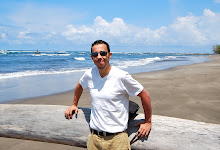
Peter Krupa - August 24, 2007
They say these days that the construction crane is China's national bird. But by all appearances, that exotic species is migratory, and at the moment it is making a stop in the central Pacific beach town of Jacó. Just glancing out her office window in the center of town, Catherine Fitton, owner of Jacó Beach Premier Realty, said she couldcount six of thegangly beasts, lifting and swiveling and dropping to build the hottest thing going at the moment: high-rise condominium towers. Of course, in Jacó least 17 high-rise condo projects are either completed, under construction or in the planning stages in and around Jacó. The Sonesta Jacó Resort project, for one, is
only just beginning the foundations on the first phase of what will be a $70 million, six-building, 13-story development. Yet it has already sold 140 of the 196 first-phase condos, priced between $215,000 and $1.2 million.
That phase should be completed in late 2008, said project manager Joshua Ten Brink, and the second phase is set to begin early next year.
Several real estate agents said the boom owes itself mostly to middle-aged,
upper middle-class buyers from the UnitedStates and Canada who have discovered Costa Rica and are buying vacation and investment condos here."I feel like we're getting to the point where the masses are starting to
become interested and know about Costa Rica," said David Karr, an agent with Century 21 Jacó Beach (643-3356,www.century21jacobeach.com). "It seems like in the past it was a hidden secret and more of a niche." Although a few large projects can be found outside Jacó - for example, the planned 12-story twin condominium towers on
Playa Hermosa, five kilometers to the south, that will be Diamond Beach
Resort if the developers manage to secure permits (TT, Feb.23) - most of the high-rise development is concentrated in the former sleepy surfer village.
The boom has some people in Jacó concerned about the town's infrastructure. "I think that we should be concerned," Fitton said. "The . local government and the central government need to be working hand in hand with the development so we don't see an overbuilding." Fisher noted that area developers have high confidence that the Central Pacific Chamber of Commerce and the new mayor of the canton of Garabito, Marvin Elizondo, will work together well to address the problems that are sure to crop up as the town gets more crowded.
He said that within the next 10 years he expects the area to look like Puerto Vallarta, Mexico, a tourist destination known for its beaches and luxury hotels. Fitton agreed, saying she thinks Jacó will soon be considered a "very nice small city, rather than the surfer village of the past."
Other Developments
High-rises may be sprouting like weeds in Jacó, but the wide-open surrounding area calls for a different kind of living arrangement. Projects involving villas, townhouses and even whole family homes in gated communities have sprung up all along the central Pacific coast.
One big one - with permits in place and earthmovers warming up - is the St.
Regis Resort, which will be a 250-acre complex with 49 condos, 42 villas and nine estate homes. Announced in 2006,the project was supposed to be opened by 2008, but
that date has been pushed back to the first quarter of 2009. A spokeswoman at Grupo Genesis, the group financing the project, said construction would start in September.
Another big project along that coast is Cabo Caletas in Esterillos, a 15-minute drive
south of Jacó. The golf course development will feature a combination of four-story condos and course-side homes. Managing partner Aaron Dowd said the entire project, once built, will have more than 1,000 condo units and costinvestors about $400 million. Cabo Caletas has yet to get the final signoff from the National Technical
Secretariat of the Environment Ministry(SETENA), and Dowd said it continues to negotiate with five-star hotel groups, "looking for a luxury brand to add to the product."
Still, Dowd said he expects to break ground on the first phase of the project next year. It will take 10 years to complete. Many other projects too numerous to mention are under way in the area to bring medium- and small-scale condo and gated community developments to the area between Jacó and Quepos.
C.R. Beach Investment Real Estate's Fisher said for foreigners coming to
live in Costa Rica (as opposed to just investing), he often recommends they buy into the individual homes going up in gated communities in the area.




